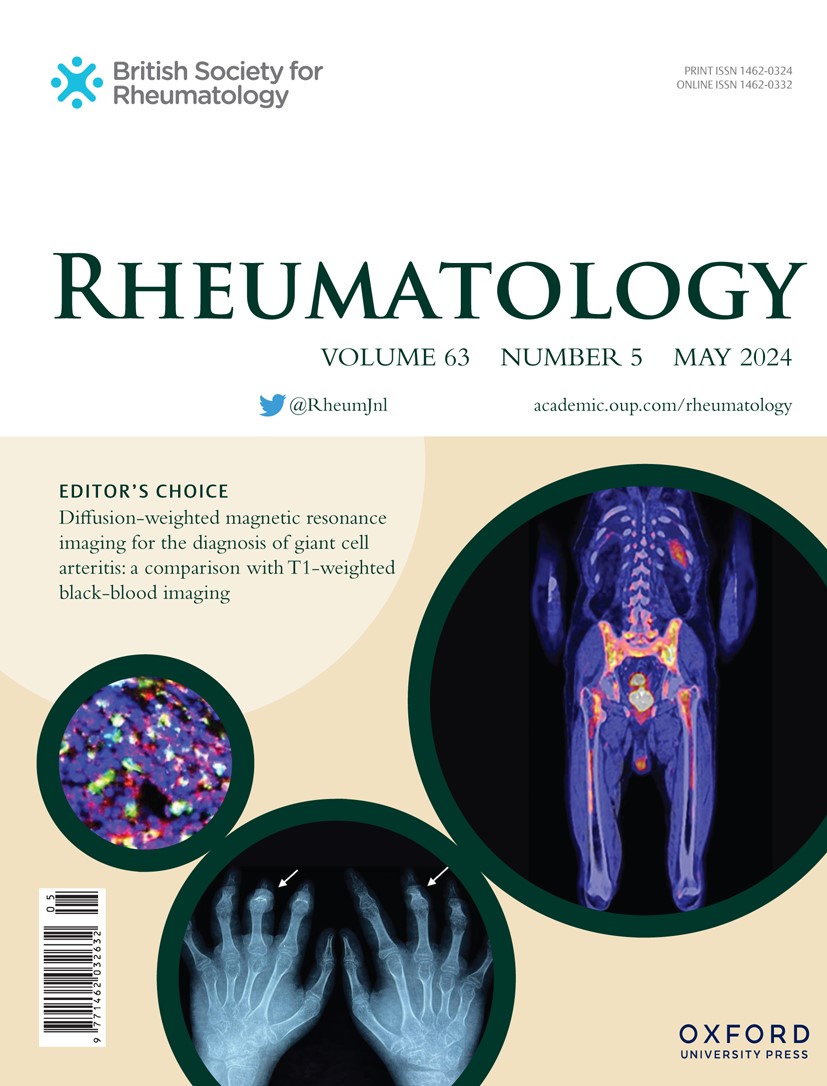Interferon-γ release assay as an emergent powerful biomarker in systemic lupus erythematosus
IF 4.7
2区 医学
Q1 RHEUMATOLOGY
引用次数: 0
Abstract
Objectives To investigate the ex vivo IFN-γ release assay (IGRA) as a biomarker of SLE activity and disease outcome. Methods This retrospective study, conducted between 2008 and 2024 at a single tertiary care center, included 145 SLE patients at various disease stages. Data were collected on spontaneous IFN-γ levels (IGRA-nil) and on phytohemagglutinin-induced IFN-γ levels (IGRA-PHA, after subtracting the IGRA-nil result). Results The ex vivo spontaneous IFN-γ release was increased (IGRA-nil; p= 0.0004) and the PHA-induced IFN-γ release was decreased in active SLE patients (IGRA-PHA; p< 1 0 −4), regardless of treatment, including glucocorticoids. Nephritis, serositis, constitutional symptoms, mucocutaneous, and musculoskeletal manifestations were associated with impaired IGRA-PHA release (p < 0.05 for each association). An IGRA-PHA ≥ 8.0 IU/ml, corresponding to the optimal Youden index, predicted clinically inactive SLE better than IGRA-nil (AUC= 0.853 vs 0.722), and IGRA-PHA <1.6 IU/ml indicated 100% specificity for active disease. Moreover, IGRA-PHA ≥ 8.0 IU/ml was an independent predictor of clinically inactive SLE in multivariate regression analysis (OR = 10.6 [95% CI: 3.72–30.17]; p = 9.7x10−6), and IGRA-PHA ≤1.6 IU/ml was associated with a longer time to achieve remission in a log-rank test (p = 2.4x10−6). Conclusion The IGRA-PHA assay appears to be a powerful and independent biomarker for clinically active SLE, when performed at the initiation or intensification of therapy, and as a predictor of treatment-induced remission at therapy evaluation.干扰素γ释放测定作为系统性红斑狼疮的新兴强有力的生物标志物
目的探讨体外IFN-γ释放试验(IGRA)作为SLE活动性和疾病结局的生物标志物。方法本回顾性研究于2008年至2024年在一家三级医疗中心进行,包括145名处于不同疾病阶段的SLE患者。收集自发IFN-γ水平(IGRA-nil)和植物血凝素诱导的IFN-γ水平(IGRA-PHA,减去IGRA-nil结果后)的数据。结果体外自发性IFN-γ释放增加(IGRA-nil;p= 0.0004),活动性SLE患者中pha诱导的IFN-γ释放减少(IGRA-PHA;p&肝移植;10−4),不论治疗方式,包括糖皮质激素。肾炎、浆膜炎、体质症状、皮肤粘膜和肌肉骨骼表现与IGRA-PHA释放受损有关(p <;每个关联值为0.05)。IGRA-PHA≥8.0 IU/ml,对应最佳约登指数,比IGRA-nil更好地预测临床非活动性SLE (AUC= 0.853 vs 0.722), IGRA-PHA≥1.6 IU/ml对活动性疾病的特异性为100%。此外,在多因素回归分析中,IGRA-PHA≥8.0 IU/ml是临床不活跃SLE的独立预测因子(OR = 10.6 [95% CI: 3.72-30.17];p = 9.7 × 10−6),在log-rank检验中,IGRA-PHA≤1.6 IU/ml与更长的缓解时间相关(p = 2.4 × 10−6)。结论IGRA-PHA检测似乎是临床活动性SLE的一个强大而独立的生物标志物,在治疗开始或强化时进行,并在治疗评估时作为治疗诱导缓解的预测因子。
本文章由计算机程序翻译,如有差异,请以英文原文为准。
求助全文
约1分钟内获得全文
求助全文
来源期刊

Rheumatology
医学-风湿病学
CiteScore
9.40
自引率
7.30%
发文量
1091
审稿时长
2 months
期刊介绍:
Rheumatology strives to support research and discovery by publishing the highest quality original scientific papers with a focus on basic, clinical and translational research. The journal’s subject areas cover a wide range of paediatric and adult rheumatological conditions from an international perspective. It is an official journal of the British Society for Rheumatology, published by Oxford University Press.
Rheumatology publishes original articles, reviews, editorials, guidelines, concise reports, meta-analyses, original case reports, clinical vignettes, letters and matters arising from published material. The journal takes pride in serving the global rheumatology community, with a focus on high societal impact in the form of podcasts, videos and extended social media presence, and utilizing metrics such as Altmetric. Keep up to date by following the journal on Twitter @RheumJnl.
 求助内容:
求助内容: 应助结果提醒方式:
应助结果提醒方式:


